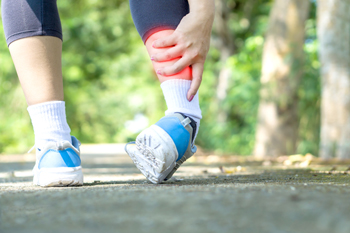 Much like adults, infants can also develop painful ingrown toenails. Fortunately, these are fairly easy to prevent. When trimming your baby’s toenails, it is suggested that you use nail clippers. This is because nail scissors tend to cut the nails in a curved or rounded shape, and it is easier for the rounded edge of the toenail to grow into the surrounding skin, whereas nail clippers can easily cut the toenails straight across. Longer toenails can make an ingrown toenail more likely to develop, so it is best that you trim your baby’s nails regularly. In some cases, this may mean once a week or more. When you do cut your baby’s toenails, please refrain from cutting them too close to the skin. It is also suggested that you let your baby go barefoot or dress them in loose-fitting socks and shoes, as tight footwear can compress the toes and push the toenails into the skin. For more information about handling ingrown toenails in infants, please consult with a podiatrist.
Much like adults, infants can also develop painful ingrown toenails. Fortunately, these are fairly easy to prevent. When trimming your baby’s toenails, it is suggested that you use nail clippers. This is because nail scissors tend to cut the nails in a curved or rounded shape, and it is easier for the rounded edge of the toenail to grow into the surrounding skin, whereas nail clippers can easily cut the toenails straight across. Longer toenails can make an ingrown toenail more likely to develop, so it is best that you trim your baby’s nails regularly. In some cases, this may mean once a week or more. When you do cut your baby’s toenails, please refrain from cutting them too close to the skin. It is also suggested that you let your baby go barefoot or dress them in loose-fitting socks and shoes, as tight footwear can compress the toes and push the toenails into the skin. For more information about handling ingrown toenails in infants, please consult with a podiatrist.
Ingrown toenails can become painful if they are not treated properly. For more information about ingrown toenails, contact Bruce Smit, DPM of Frankfort Foot & Ankle Clinic. Our doctor can provide the care you need to keep you pain-free and on your feet.
Ingrown Toenails
Ingrown toenails occur when a toenail grows sideways into the bed of the nail, causing pain, swelling, and possibly infection.
Causes
Prevention
Because ingrown toenails are not something found outside of shoe-wearing cultures, going barefoot as often as possible will decrease the likeliness of developing ingrown toenails. Wearing proper fitting shoes and using proper cutting techniques will also help decrease your risk of developing ingrown toenails.
Treatment
Ingrown toenails are a very treatable foot condition. In minor cases, soaking the affected area in salt or antibacterial soaps will not only help with the ingrown nail itself, but also help prevent any infections from occurring. In more severe cases, surgery is an option. In either case, speaking to your podiatrist about this condition will help you get a better understanding of specific treatment options that are right for you.
If you have any questions please feel free to contact our office located in Frankfort, IL . We offer the newest diagnostic and treatment technologies for all your foot and ankle needs.
 The cuboid is a cube-shaped bone located in the middle of the foot. Since this bone is in an area that is not directly involved in bearing weight, an injury to the cuboid bone is not common. Nevertheless, it is still wise to be on the lookout for any signs of injury to the cuboid bone. Cuboid syndrome occurs when the cuboid bone is knocked out of its proper alignment, typically due to another injury, such as an ankle sprain, or from repetitive stress being placed on the bone. Symptoms of this condition include foot pain, bruising, swelling, and a reduced range of motion in the foot. Cuboid syndrome can be diagnosed through physical examination and treatments are typically conservative. If you are experiencing the symptoms of cuboid syndrome, it is recommended that you seek the care of a podiatrist.
The cuboid is a cube-shaped bone located in the middle of the foot. Since this bone is in an area that is not directly involved in bearing weight, an injury to the cuboid bone is not common. Nevertheless, it is still wise to be on the lookout for any signs of injury to the cuboid bone. Cuboid syndrome occurs when the cuboid bone is knocked out of its proper alignment, typically due to another injury, such as an ankle sprain, or from repetitive stress being placed on the bone. Symptoms of this condition include foot pain, bruising, swelling, and a reduced range of motion in the foot. Cuboid syndrome can be diagnosed through physical examination and treatments are typically conservative. If you are experiencing the symptoms of cuboid syndrome, it is recommended that you seek the care of a podiatrist.
Cuboid syndrome, also known as cuboid subluxation, occurs when the joints and ligaments near the cuboid bone in the foot become torn. If you have cuboid syndrome, consult with Bruce Smit, DPM from Frankfort Foot & Ankle Clinic. Our doctor will assess your condition and provide you with quality foot and ankle treatment.
Cuboid syndrome is a common cause of lateral foot pain, which is pain on the outside of the foot. The condition may happen suddenly due to an ankle sprain, or it may develop slowly overtime from repetitive tension through the bone and surrounding structures.
Causes
The most common causes of cuboid syndrome include:
Symptoms
A common symptom of cuboid syndrome is pain along the outside of the foot which can be felt in the ankle and toes. This pain may create walking difficulties and may cause those with the condition to walk with a limp.
Diagnosis
Diagnosis of cuboid syndrome is often difficult, and it is often misdiagnosed. X-rays, MRIs and CT scans often fail to properly show the cuboid subluxation. Although there isn’t a specific test used to diagnose cuboid syndrome, your podiatrist will usually check if pain is felt while pressing firmly on the cuboid bone of your foot.
Treatment
Just as the range of causes varies widely, so do treatments. Some more common treatments are ice therapy, rest, exercise, taping, and orthotics.
If you have any questions, please feel free to contact our office located in Frankfort, IL . We offer the newest diagnostic and treatment technologies for all your foot care needs.
 When children learn to walk, it is beneficial to have them walk barefoot while indoors. When it is time to walk outdoors, it is important to ensure they wear shoes that fit correctly. This can be accomplished by having your child’s feet properly measured by using a Brannock device. The majority of children have feet that are different sizes, and the larger size shoe should be purchased. When the shoes are tried on, it is beneficial to have the child wiggle their toes to make sure there is adequate room in the top of the shoe. Shoes that are comfortable are often made from breathable materials and are lightweight. If you would like additional information about how to buy shoes for your child, please consult with a podiatrist who can help you to choose the correct shoes.
When children learn to walk, it is beneficial to have them walk barefoot while indoors. When it is time to walk outdoors, it is important to ensure they wear shoes that fit correctly. This can be accomplished by having your child’s feet properly measured by using a Brannock device. The majority of children have feet that are different sizes, and the larger size shoe should be purchased. When the shoes are tried on, it is beneficial to have the child wiggle their toes to make sure there is adequate room in the top of the shoe. Shoes that are comfortable are often made from breathable materials and are lightweight. If you would like additional information about how to buy shoes for your child, please consult with a podiatrist who can help you to choose the correct shoes.
The health of a child’s feet is vital to their overall well-being. If you have any questions regarding foot health, contact Bruce Smit, DPM of Frankfort Foot & Ankle Clinic. Our doctor can provide the care you need to keep you pain-free and on your feet.
Tips for Keeping Children's Feet Healthy
If you have any questions, please feel free to contact our office located in Frankfort, IL . We offer the newest diagnostic and treatment technologies for all your foot care needs.
 Ankle sprains occur when a ligament in the ankle is overstretched or torn, and they are often caused by the foot suddenly turning inward during walking, running, or jumping activities. Athletes, especially those involved in sports such as soccer, basketball, football, and tennis, are particularly prone to ankle sprains because these sports require pivoting motions that put the ankle at risk. There are measures that you can take to prevent ankle sprains, including running on flat surfaces, wearing protective gear while playing sports, warming up prior to exercise, exercising regularly, maintaining a healthy weight, and wearing shoes that fit properly. If you have suffered an ankle sprain, it is suggested that you seek the care of a podiatrist.
Ankle sprains occur when a ligament in the ankle is overstretched or torn, and they are often caused by the foot suddenly turning inward during walking, running, or jumping activities. Athletes, especially those involved in sports such as soccer, basketball, football, and tennis, are particularly prone to ankle sprains because these sports require pivoting motions that put the ankle at risk. There are measures that you can take to prevent ankle sprains, including running on flat surfaces, wearing protective gear while playing sports, warming up prior to exercise, exercising regularly, maintaining a healthy weight, and wearing shoes that fit properly. If you have suffered an ankle sprain, it is suggested that you seek the care of a podiatrist.
Sports related foot and ankle injuries require proper treatment before players can go back to their regular routines. For more information, contact Bruce Smit, DPM of Frankfort Foot & Ankle Clinic. Our doctor can provide the care you need to keep you pain-free and on your feet.
Sports Related Foot and Ankle Injuries
Foot and ankle injuries are a common occurrence when it comes to athletes of any sport. While many athletes dismiss the initial aches and pains, the truth is that ignoring potential foot and ankle injuries can lead to serious problems. As athletes continue to place pressure and strain the area further, a mild injury can turn into something as serious as a rupture and may lead to a permanent disability. There are many factors that contribute to sports related foot and ankle injuries, which include failure to warm up properly, not providing support or wearing bad footwear. Common injuries and conditions athletes face, including:
Sports related injuries are commonly treated using the RICE method. This includes rest, applying ice to the injured area, compression and elevating the ankle. More serious sprains and injuries may require surgery, which could include arthroscopic and reconstructive surgery. Rehabilitation and therapy may also be required in order to get any recovering athlete to become fully functional again. Any unusual aches and pains an athlete sustains must be evaluated by a licensed, reputable medical professional.
If you have any questions please feel free to contact our office located in Frankfort, IL . We offer the newest diagnostic and treatment technologies for all your foot and ankle needs.
 Running is a wonderful sport for maintaining your cardiovascular health and overall fitness, however, it can increase your risk of getting a foot or ankle injury. Two of the most common running injuries are plantar fasciitis and Achilles tendonitis. Plantar fasciitis often presents itself as a stabbing pain in the heel, or pain in the arch of the foot. This is an overuse injury that is the result of repetitive stress on the plantar fascia, a ligament that runs along the bottom of the foot and connects the heel bone to the toes. Achilles tendonitis is an inflammation of the Achilles tendon, a fibrous cord that connects the muscles in the back of your calf to the heel bone. Achilles tendonitis is caused by small tears in the tendon due to overuse. Many running injuries can be prevented by regularly warming up, doing strengthening exercises, resting, and wearing the right shoes. However, if you find yourself with a persistent foot or ankle injury, it is suggested that you seek the care of a podiatrist.
Running is a wonderful sport for maintaining your cardiovascular health and overall fitness, however, it can increase your risk of getting a foot or ankle injury. Two of the most common running injuries are plantar fasciitis and Achilles tendonitis. Plantar fasciitis often presents itself as a stabbing pain in the heel, or pain in the arch of the foot. This is an overuse injury that is the result of repetitive stress on the plantar fascia, a ligament that runs along the bottom of the foot and connects the heel bone to the toes. Achilles tendonitis is an inflammation of the Achilles tendon, a fibrous cord that connects the muscles in the back of your calf to the heel bone. Achilles tendonitis is caused by small tears in the tendon due to overuse. Many running injuries can be prevented by regularly warming up, doing strengthening exercises, resting, and wearing the right shoes. However, if you find yourself with a persistent foot or ankle injury, it is suggested that you seek the care of a podiatrist.
Exercising your feet regularly with the proper foot wear is a great way to prevent injuries. If you have any concerns about your feet, contact Bruce Smit, DPM of Frankfort Foot & Ankle Clinic. Our doctor will treat your foot and ankle needs.
How to Prevent Running Injuries
Many common running injuries are caused by overuse and overtraining. When the back of the kneecap starts wearing out and starts causing pain in your knee, this is commonly referred to as runner’s knee. Runner’s knee is a decrease in strength in your quadriceps and can occur if you’re not wearing properly fitted or supporting shoes. To prevent runner’s knee, focusing on hip strengthening is a good idea, as well as strengthening your quads to keep the kneecaps aligned.
What Are Some Causes of Running Injuries?
- One cause of a common running injury is called iliotibial band syndrome.
- Plantar fasciitis is also another common injury.
- Stress fractures can occur from overtraining, lack of calcium, or even your running style.
Best Ways to Prevent Running Injuries
- Wear footwear that fits properly and suits your running needs.
- Running shoes are the only protective gear that runners have to safeguard them from injury.
- Make a training schedule. Adding strengthening exercises as well as regular stretching can help keep you strong and limber and can lessen the possibility of injuries.
- Stretching keeps muscles limber; this will help you gain better flexibility.
If you have any questions please feel free to contact our office located in Frankfort, IL . We offer the newest diagnostic and treatment technologies for all your foot and ankle needs.
 A broken toe bone is typically the result of trauma, such as stubbing your toe. If you have broken your big toe you will likely feel pain at the time of injury. You may also see swelling and bruising, and in severe cases, the toe can also become deformed. A fracture in one of the smaller toes may not be as noticeable. A broken toe is usually diagnosed through a physical examination and imaging studies, such as an X-ray. Common treatments include resting and icing the foot, wearing a walking boot, or taping the injured toe to the adjacent toes for stability while the broken toe heals. If you believe that you have broken your toe, it is recommended that you see a podiatrist for treatment as soon as possible.
A broken toe bone is typically the result of trauma, such as stubbing your toe. If you have broken your big toe you will likely feel pain at the time of injury. You may also see swelling and bruising, and in severe cases, the toe can also become deformed. A fracture in one of the smaller toes may not be as noticeable. A broken toe is usually diagnosed through a physical examination and imaging studies, such as an X-ray. Common treatments include resting and icing the foot, wearing a walking boot, or taping the injured toe to the adjacent toes for stability while the broken toe heals. If you believe that you have broken your toe, it is recommended that you see a podiatrist for treatment as soon as possible.
A broken toe can be very painful and lead to complications if not properly fixed. If you have any concerns about your feet, contact Bruce Smit, DPM from Frankfort Foot & Ankle Clinic. Our doctor will treat your foot and ankle needs.
What to Know About a Broken Toe
Although most people try to avoid foot trauma such as banging, stubbing, or dropping heavy objects on their feet, the unfortunate fact is that it is a common occurrence. Given the fact that toes are positioned in front of the feet, they typically sustain the brunt of such trauma. When trauma occurs to a toe, the result can be a painful break (fracture).
Symptoms of a Broken Toe
Generally, it is best to stay off of the injured toe with the affected foot elevated.
Severe toe fractures may be treated with a splint, cast, and in some cases, minor surgery. Due to its position and the pressure it endures with daily activity, future complications can occur if the big toe is not properly treated.
If you have any questions please feel free to contact our office located in Frankfort, IL . We offer the newest diagnostic and treatment technologies for all your foot and ankle needs.
 Peripheral artery disease (PAD) is a condition in which blood flow to the lower limbs is reduced or completely blocked by a buildup of plaque in the arteries. PAD rarely has noticeable symptoms in the initial stages. Many people with this condition will not experience any symptoms until the plaque buildup in an artery has caused a large blockage. When symptoms do arise, they typically begin with claudication, a specific type of leg pain that occurs when walking and typically can get better with rest. Claudication occurs because the muscles in the legs don’t have an adequate blood supply to sustain them during activity. If you are experiencing this symptom, it is suggested that you see a podiatrist, who can help diagnose and treat PAD.
Peripheral artery disease (PAD) is a condition in which blood flow to the lower limbs is reduced or completely blocked by a buildup of plaque in the arteries. PAD rarely has noticeable symptoms in the initial stages. Many people with this condition will not experience any symptoms until the plaque buildup in an artery has caused a large blockage. When symptoms do arise, they typically begin with claudication, a specific type of leg pain that occurs when walking and typically can get better with rest. Claudication occurs because the muscles in the legs don’t have an adequate blood supply to sustain them during activity. If you are experiencing this symptom, it is suggested that you see a podiatrist, who can help diagnose and treat PAD.
Peripheral artery disease can pose a serious risk to your health. It can increase the risk of stroke and heart attack. If you have symptoms of peripheral artery disease, consult with Bruce Smit, DPM from Frankfort Foot & Ankle Clinic. Our doctor will assess your condition and provide you with quality foot and ankle treatment.
Peripheral artery disease (PAD) is when arteries are constricted due to plaque (fatty deposits) build-up. This results in less blood flow to the legs and other extremities. The main cause of PAD is atherosclerosis, in which plaque builds up in the arteries.
Symptoms
Symptoms of PAD include:
It is important to note that a majority of individuals never show any symptoms of PAD.
Diagnosis
While PAD occurs in the legs and arteries, Podiatrists can diagnose PAD. Podiatrists utilize a test called an ankle-brachial index (ABI). An ABI test compares blood pressure in your arm to you ankle to see if any abnormality occurs. Ultrasound and imaging devices may also be used.
Treatment
Fortunately, lifestyle changes such as maintaining a healthy diet, exercising, managing cholesterol and blood sugar levels, and quitting smoking, can all treat PAD. Medications that prevent clots from occurring can be prescribed. Finally, in some cases, surgery may be recommended.
If you have any questions, please feel free to contact our office located in Frankfort, IL . We offer the newest diagnostic and treatment technologies for all your foot care needs.
 Pain is often present with ingrown toenails. They occur as the outer edge of the toenail grows into the skin, and they generally require prompt treatment. The symptoms that are typically associated with ingrown toenails include pain and discomfort, swelling, and a discharge from the skin surrounding the nail may be present in severe cases. Ingrown toenails can develop as a result of genetic factors, from wearing shoes that do not have adequate room for the toes to move freely in, or from improperly trimming the toenails. Patients who have this ailment may find mild relief when the affected foot is soaked in warm water, followed by using a piece of cotton to gently pull the skin away from the nail. If you have developed an ingrown toenail, it is strongly recommended that you speak with a podiatrist who can help you determine the best course of treatment.
Pain is often present with ingrown toenails. They occur as the outer edge of the toenail grows into the skin, and they generally require prompt treatment. The symptoms that are typically associated with ingrown toenails include pain and discomfort, swelling, and a discharge from the skin surrounding the nail may be present in severe cases. Ingrown toenails can develop as a result of genetic factors, from wearing shoes that do not have adequate room for the toes to move freely in, or from improperly trimming the toenails. Patients who have this ailment may find mild relief when the affected foot is soaked in warm water, followed by using a piece of cotton to gently pull the skin away from the nail. If you have developed an ingrown toenail, it is strongly recommended that you speak with a podiatrist who can help you determine the best course of treatment.
Ingrown toenails can become painful if they are not treated properly. For more information about ingrown toenails, contact Bruce Smit, DPM of Frankfort Foot & Ankle Clinic. Our doctor can provide the care you need to keep you pain-free and on your feet.
Ingrown Toenails
Ingrown toenails occur when a toenail grows sideways into the bed of the nail, causing pain, swelling, and possibly infection.
Causes
Prevention
Because ingrown toenails are not something found outside of shoe-wearing cultures, going barefoot as often as possible will decrease the likeliness of developing ingrown toenails. Wearing proper fitting shoes and using proper cutting techniques will also help decrease your risk of developing ingrown toenails.
Treatment
Ingrown toenails are a very treatable foot condition. In minor cases, soaking the affected area in salt or antibacterial soaps will not only help with the ingrown nail itself, but also help prevent any infections from occurring. In more severe cases, surgery is an option. In either case, speaking to your podiatrist about this condition will help you get a better understanding of specific treatment options that are right for you.
If you have any questions please feel free to contact our office located in Frankfort, IL . We offer the newest diagnostic and treatment technologies for all your foot and ankle needs.
Plantar fasciitis is a condition in which the ligament at the bottom of the foot, the plantar fascia, becomes inflamed due to repetitive stress or injury. It can cause heel pain, which is typically at its worst when first arising in the morning. The goal of plantar fasciitis treatment is to reduce pain and inflammation. Decreasing stress on the plantar fascia may help with this and can be achieved by resting the foot, avoiding activities that aggravate the plantar fascia, such as running or jogging, and wearing shoes or orthotics that provide more support to the arch area. Icing the foot for 15-20 minutes using an ice pack wrapped in a towel can decrease inflammation. Massaging the foot across the width of the plantar fascia can reduce pain from standing. Stretching and strengthening exercises for the foot can help prevent plantar fascia injuries in the future. If you are experiencing plantar fasciitis pain that does not get better with home treatment, it is suggested that you consult with a podiatrist.
Plantar fasciitis can be very painful and inconvenient. If you are experiencing heel pain or symptoms of plantar fasciitis, contact Bruce Smit, DPM from Frankfort Foot & Ankle Clinic. Our doctor can provide the care you need to keep you pain-free and on your feet.
What Is Plantar Fasciitis?
Plantar fasciitis is the inflammation of the thick band of tissue that runs along the bottom of your foot, known as the plantar fascia, and causes mild to severe heel pain.
What Causes Plantar Fasciitis?
How Can It Be Treated?
While very treatable, plantar fasciitis is definitely not something that should be ignored. Especially in severe cases, speaking to your doctor right away is highly recommended to avoid complications and severe heel pain. Your podiatrist can work with you to provide the appropriate treatment options tailored to your condition.
If you have any questions please feel free to contact our office located in Frankfort, IL . We offer the newest diagnostic and treatment technologies for all your foot and ankle needs.